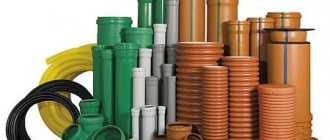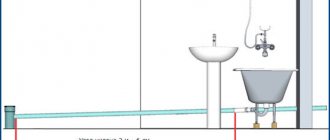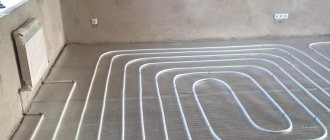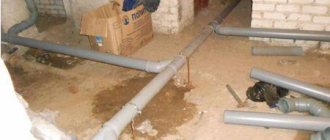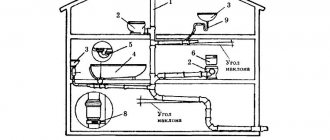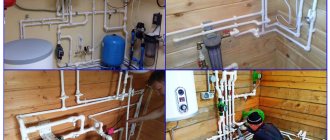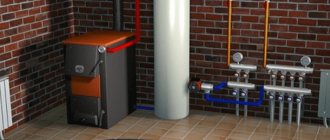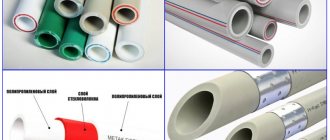Owners of apartments on the top floors of apartment buildings, as well as owners of private low-rise housing, often express their displeasure about the thick pipe in the toilet that spoils the interior, going into the ceiling and then onto the roof. The liquid does not drain through it - the drainage is carried out below, so some people want to get rid of this bulky structure for the sake of aesthetics. Is this possible, and in what cases? Why is this pipe needed at all? Let's try to figure it out by referring to the requirements of domestic construction standards, including SP 30.13330.2012 “Internal water supply and sewerage of buildings,” as well as taking into account practical realities.
What it is
When a private house is built, it is necessary to connect various communications to it. One of them is sewerage. At first glance, you might think that it is enough to equip it with only a sewer drain. In fact, this is not enough.
In order to explain the purpose of the vent riser, you need to remember how the toilet flushes in more detail. After the sewage is drained, a certain amount of water then gets there. Some of it remains in the toilet. It is actually a water seal, the role of which, in particular, is to prevent the unpleasant odor from the drains from entering the living quarters. It is important to understand that this protective layer of water is located inside the toilet.
If several such plumbing fixtures are installed in the house, then each of them, which is not currently in use, has such a water seal.
When one of the toilets is flushed, the pressure drops for a short period of time immediately after the sewage and drained water flows out. Since all the others are connected to this pipe, their water seals are broken and an unpleasant odor penetrates into the premises.
Diagram of the design and operation of the sewerage ventilation system Source profidom.com.ua
It is important to note that this situation exists not only in relation to toilets, but to all drains that are connected to the sewer system. For example, we can talk about a water seal in a bathroom or in a sink, if they are connected in the specified way.
This situation could have been avoided if the pipe had an additional outlet through which air could freely flow into it. In this case, low pressure would not arise at the drainage point and the water seals would not be broken anywhere.
Odors from the sewer could also escape through such a pipe. A sewer riser is a pipe that performs the specified functions, which is connected to the sewer system of the house and led outside it.
How necessary is it? In fact, the system in question is actively used in apartment buildings. In the sewer system, drainage from apartments occurs in a vertical pipe.
A system of vertical sewer pipes that performs the function of a drain riser Source ar.decorexpro.com
Its lower end is connected to the drainage system, and the upper end is brought out onto the roof and actually serves as a drain riser.
General information
The mass of sewage that arises during the flushing of wastewater into the system, entering the main line, acts like a pump. Before the drain, the pressure indicator increases, and after them it decreases.
If the ventilation section of the line is not provided during use, the water seal will fail. Air mass is sucked through the drain hole of plumbing fixtures. The effect allows gases to enter the building.
This problem happens with devices with a weak water seal. But sometimes a breakdown occurs in several areas at once. It is accompanied by characteristic gurgling sounds appearing in the drain holes.
If the line is equipped with a ventilation section, air enters the line absolutely freely.
Due to this, the pressure indicator stabilizes. There is no failure of the water seals. Accordingly, the smell of sewage does not penetrate into the room.
Technical requirements
The outlet pipe does not have any specific diameter requirements. Typically, a pipe similar to a sewer pipe is used for this purpose in apartment buildings.
Let’s assume that in a private house, a pipe with a diameter of 5 cm is used for drainage from the sink, the opening of the flush tank is 7 cm, and the pipe from the toilet is 10 cm. In this case, a drain pipe on the roof with a diameter of 10 cm can be used for the drain riser.
Practice confirms that such a pipe is sufficient to ensure constant pressure in the drainage system and to provide ventilation in it. If we are talking about a one-story private house in which only one toilet is installed, then here you can do without installing a vent riser.
Air supply and exhaust system Source gardeneer.me
This is due to the fact that the drain in this case will not be able to create a strong enough decrease in pressure so that unpleasant consequences can be felt.
However, in some cases, roof risers are necessary:
- If the house has at least two apartments with fully equipped sewerage systems, provided that they are connected to a common network.
- A sewer outlet to the roof for ventilation of the riser is required in a house with more than two floors .
- If there is an equipped horizontal sewer distribution system , provided that three or more plumbing fixtures are connected to it.
Fan exhaust pipe on the roof Source teplogidromash.ru
It is also necessary to provide:
- risers usually have a diameter of 10 cm, however, sometimes there are situations when a pipe with a diameter of 5 cm . Then the outlet of the vent pipe to the roof is mandatory .
- If the house has a swimming pool that discharges water into the sewer system , the use of the design in question is also necessary . This is due to the fact that in such a situation a large amount of water can be discharged.
- A vent riser and access to the roof are needed in cases where the drainage occurs into private septic tanks located next to the house .
- If the house is one-story , but the bathroom and toilet are located on different levels, and the drainage occurs in one pipe .
Fan pipe with outlet to the roof Source forumhouse.ru
See also: Catalog of companies that specialize in water supply and sewerage.
Do I need to insulate and soundproof?
It is not at all necessary to insulate sewer pipelines passing through residential premises, as well as sewer pipelines. But in an unheated attic it is worth making at least minimal thermal insulation of the pipes so that during severe frosts the ice does not freeze inside, since water vapor is much lighter than air, and they will tend to rise up the pipe, where they will freeze on the cold walls.
Insulated pipe
Sound insulation of the drain pipe must be carried out only if it passes openly through residential premises. If this cannot be avoided, then the insulation work is quite simple and is carried out in the same way as for all sewer pipelines with the same ease. The only thing that complicates the process is the variety of acoustic processes in pipes, which directly depend on the materials from which the pipelines are made.
Thus, the sound insulation properties of cast iron pipes are much better than those of their plastic counterparts. This is due primarily to the properties of the granular structure of cast iron and the larger wall thickness, so such pipes, as a rule, do not require additional sound insulation.
Sound processes occurring in plastic pipes can be divided into four main components:
- Impact nature, when falling water and feces repeatedly hit the walls of the riser;
- Atmospheric nature is the penetration of wind and precipitation noise through the outer part of the pipeline;
- Resonant nature from the presence of extraneous noise in the pipes caused by the interaction of the sewer pipeline with the building structures;
- Vibrations that occur when there is contact with any operating equipment.
Sound insulation of a drain pipe
The main part of the work on sound insulation should be carried out at the design stage of a residential building, so that all sewer risers do not pass through residential premises and are installed exclusively in special boxes or sewer shafts, which themselves are shielding devices and prevent the spread of noise .
If, after all, the vent pipe is located open in a living room, then it can be easily soundproofed by wrapping the pipe with strips of inexpensive polyethylene foam in two or three layers.
Carrying out installation
When installing a riser, it is important to pay attention to some points:
- There is no need to underestimate the diameter of the outlet pipe. If it is too narrow, then its thickness may not be enough for quality work. A pipe with a diameter of 100 mm is most suitable for this purpose.
- The horizontal part of the sewer system should not be located at the same level . In this case, there is a risk of water or air locks forming. It is recommended that the pipe be installed with a slight slope . It is usually considered sufficient to use a slope of two centimeters per meter of length for this purpose.
- Sometimes when installing the system, the riser is led not to the roof, but to the attic . This is strictly not recommended. Exposure to escaping air insulation to become saturated with moisture. Another consequence may be rotting of the rafters.
- a deflector is sometimes installed on its hole . It will protect against precipitation and random debris. Additionally, its effect in windy weather will be expressed in increased traction . But there is another opinion. It is believed that this or another additional device installed above the pipe opening contributes to the formation of condensation , which in frosty winter weather will lead to icing of the pipe from the inside. As a result, it will be partially clogged and may cease to perform its functions.
Example of an L-shaped fan pipe Source allremont59.ru
When carrying out installation, you need to consider:
- to move the sewer riser pipe away from the vertical sewer drain. If for some reason this is difficult to do, then the transition connection is best made using corrugated pipes.
- It is believed that the height of the pipe above the roof should be 50 cm . It is recommended to locate the roof exit at a distance of at least 4 meters from balconies or windows.
- The reliability of the system will be higher if you install a check valve. It is installed where the drainage into the public sewer pipe. Its effect is that drains from an apartment or house pass freely , and gases and liquids the opposite direction at all.
Is it necessary to put it on the roof?
Sometimes in apartment buildings, residents of the upper floor themselves dismantle the riser pipe leading upward.
Check valve operation diagram Source ufa-santehnik.ru
The motivation for this decision is insufficient knowledge of the principles of sewerage operation and the idea of a drain riser as something superfluous and unnecessary. Soon after this, a persistent smell from the sewer pipe appears on the upper floors.
The situation can be improved. In this case, there is no need to install vent pipes on the roof. It is enough to attach a special valve to it. It will not release air outside, but when a low pressure zone forms, it will let air in, which will prevent the water seals from breaking.
There is no need to put such a riser on the roof. The valve must be installed at the top of the sewer pipe system. Although this is convenient (there is no need to install a pipe passing through the roof), such a device is not highly reliable.
Vacuum valve for installation at the top of sewer pipes Source drive2.ru
What materials is it made from?
Both the wastewater pipe and the sewer pipe are the same type of pipes. This means that they are made from the same materials - plastic or cast iron:
- Plastic ones are cheaper, more convenient to install and use.
- Cast iron is stronger and more durable, but working with them due to its impressive weight and fragility is more difficult. In addition, cast iron ones become dirty faster during operation.
Some tips
To install a fan riser, you should pay attention to the following:
- When bringing the pipe to the roof, you need to cover the hole with a grill . This is necessary to protect against birds.
- Sometimes when this system operates, a low, unpleasant noise . In order to get rid of it, you will need to wrap the pipe with a soundproofing coating.
- It is not always possible to bring from each to the roof . In this case, you can provide one pipe for several risers .
Options for exhaust pipe outlets Source td-intech.ru
Recommendations for use
It is almost impossible to repair a cast iron riser. Previously, bandages made of fabric and cement were used in leaky areas of pipes. Modern plastic risers are much more practical, so they are replaced whenever possible.
Maintenance of the fan riser comes down to the following actions:
- periodic inspection;
- cleaning the inspection element;
- repair (replacement of damaged areas).
It is not difficult to repair a plastic hood; to do this, carefully remove the damaged area and replace it with a new pipe . They act in a similar way when changing elbows, turns, and adapters. Along with them, old rubber gaskets are also replaced with new products.
We must not forget about the insulation and soundproofing of fan pipes. They use polyurethane foam, slab foam, expanded polystyrene, and rolled cotton wool; when the layers are destroyed, they are replaced with new ones.
Installation of a fan riser
Plastic or cast iron pipes can be used for this. There are several options for laying them. It can be straight, oblique or with a horizontal section. The first of these options is considered the most effective, but it cannot be implemented in all cases. Less suitable is the location of the fan pipe at an angle.
Options for laying the fan riser, pipe material and outlet openings vary Source sovet-ingenera.com
If it is not possible to carry out the installation using the previous methods, then you will have to use an installation where a horizontal section of the pipe will be used. It is laid within the attic from the point where it will be possible to install a vertical pipe.
The exhaust pipe exits to the roof using one of the following methods:
- It can be made in the form of a pipe on the roof .
- Sometimes it is done through the wall under the roof slope.
- Sometimes it happens that the outlet is located inside the attic .
The last option is of lower quality. At the same time, moisture escapes through the pipe, which can lead to condensation and rotting of the roof. In addition, sewer odors spread through the pipe. When it is located on the roof, this impact is minimized.
The second option is considered vulnerable to icing.
Valve system for a riser in the attic Source dretun.ru
In the attic, you can equip an exit from the riser only if you install a special valve there, which can only let air in, but not out.
Dimensions
There is no separate part called a fan pipe, regardless of size.
This design includes:
- regular tee;
- lid or grill;
- one or more pipes;
- safety valve.
The dimensions of drainage pipes for sewerage, as well as for toilets, depend on the specific conditions of their operation.
The following rules must be followed:
- You can use parts from any materials;
- The size of the pipes for the exhaust riser, including the length, may vary.
Today, the most popular are plastic fan pipes with diameters from 110 to 50 mm, regardless of other linear dimensions (length).
Using a 110x45 ani plast w4220 drain pipe, which can be of different sizes, it is convenient to connect the sewerage system to the toilet outlet. Such a detail will seem to glue the toilet bowl to the sewer riser, which will ensure that there are no leaks in the bathroom. The size of the toilet drain pipe depends on the diameters of the drain, sewer riser, and the distance of these elements to the wall or ceiling.
The diameter of the part must be such that the maximum possible sewer flows do not interfere with its normal functioning. Sometimes ventilation and sewage systems are constructed from risers of different diameters. Then you need to use a special adapter.
There is a catalog where you can select the necessary parameters of parts for arranging an exhaust system.
Important! The ideal location for the exhaust riser is the place where the internal and external sewers are connected.

